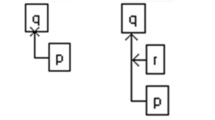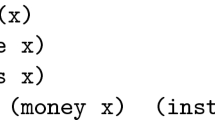Abstract
Few automated legal reasoning systems have been developed in domains of law in which a judicial decision maker has extensive discretion in the exercise of his or her powers. Discretionary domains challenge existing artificial intelligence paradigms because models of judicial reasoning are difficult, if not impossible to specify. We argue that judicial discretion adds to the characterisation of law as open textured in a way which has not been addressed by artificial intelligence and law researchers in depth. We demonstrate that systems for reasoning with this form of open texture can be built by integrating rule sets with neural networks trained with data collected from standard past cases. The obstacles to this approach include difficulties in generating explanations once conclusions have been inferred, difficulties associated with the collection of sufficient data from past cases and difficulties associated with integrating two vastly different paradigms. A knowledge representation scheme based on the structure of arguments proposed by Toulmin has been used to overcome these obstacles. The system, known as Split Up, predicts judicial decisions in property proceedings within family law in Australia. Predictions from the system have been compared to those from a group of lawyers with favourable results.
Similar content being viewed by others
References
Aikenhead, M. 1996. The uses and abuses of neural networks in law, Santa Clara Computer and High Technology Law Journal 12(1), 31–70.
Ball, W.J. 1994. Using Virgil to analyse public policy arguments: a system based on Toulmin's informal logic, Social Science Computer Review 12(1), 26–37.
Bench-Capon T.J.M, Lowes, D., and McEnery, A. M. 1991. Argument-Based Explanation of Logic Programs, Volume 4,No 3. Knowledge Based Systems, pp. 177–183.
Bench-Capon, T.J.M. 1993. Neural networks and open-texture. In Proceedings of the Fourth International Conference on Artificial Intelligence and Law. Amsterdam: ACM Press, pp. 292–297.
Bochereau, L., Bourcier, D., and Bourgine, P.: 1991. Extracting legal knowledge by means of a multilayer neural network application to municipal jurisprudence. Proceedings of the Third International Conference on Artificial Intelligence and Law. Oxford. ACM Press, p. 288.
Branting, K.L. 1994. A computational model of ratio decidendi, Artificial Intelligence and Law 2, 1–31.
Clark, P. 1991. A Model of Argumentation and Its Application in a Cooperative Expert System. PhD thesis. Turing Institute. Glasgow: Department of Computer Science, University of Strathclyde.
Cohen, P. 1985. Heuristic Reasoning about Uncertainty: An Artificial Intelligence Approach. London, Pitman.
Cybenko, G. 1989. Approximation by superpositions of a sigmoidal function, Mathematics of Control, Signals and Systems 2, 303–314
Descartes, R.A. 1650. Discourse on the Method, translated by J. Veith, 1912. London: J.M. Dent Pty Ltd. Last printed in 1965.
Dick, J.P. 1991. A Conceptual, Case-Relation Representation of Text for Intelligent Retrieval. Ph.D Thesis. Canada: University of Toronto.
Diederich, J. 1992. Explanation and artificial neural networks, International Journal of Man-Machine Studies. 37, 35–355.
Dung, Phan Minh. 1995. On the acceptability of arguments and its fundamental role in nonmonotonic reasoning, logic programming and n-person games, Artificial Intelligence 7(2), 321–357.
Dworkin, R. 1977. Taking Rights Seriously. Cambridge: Harvard University Press.
Dworkin, R.M. 1967. The model of rules. University of Chicago Law Review 38, 14–46.
Eberhart, R.C. 1995. Using evolutionary computation tools in explanation facilities, International Journal of Expert Systems 8(3), 277–285.
Edwards, L. and Huntley, J.A.K. 1992. Creating a civil jurisdiction adviser. Law, Computers & Artificial Intelligence 1(1), 5–40.
Farley, A.M. and Freeman, K. 1995. Burden of proof in legal argumentation. Proceedings of Fifth International Conference on Artificial Intelligence and Law. May 21–24. Boston: ACM Press, USA, pp. 156–164.
Fayyad, U, Piatetsky-Shapiro, G., and Smyth, P. 1996. The KDD process for extracting useful knowledge from volumes of data, Communications of the ACM. 39(11), 27–41.
Fox, J. 1986. Knowledge, decision making and uncertainty. In W.A. Gale (ed.), Artificial Intelligence and Statistics. Reading, MA: Addison-Wesley.
Frawley, W.J., Piatetsky-Shapiro, G., and Matheus, C.J. 1991. Knowledge Discovery in Databases: An Overview. AAAI: MIT Press, pp. 1–27.
Gordon, T.F. 1993. The pleadings game. Proceedings of Fourth International Conference on Artificial Intelligence and Law. Oxford, New York: ACM Press.
Hart, H.L.A. 1994. The Concept of Law. 2nd ed. Oxford: Clarendon Press.
Hobson, J.B. and Slee, D. 1994. Indexing the Theft Act 1968 for case based reasoning and artificial neural networks, Proceedings of the Fourth National Conference on Law, Computers and Artificial Intelligence. Exeter.
Haykin, S. 1994. Neural Networks: A Comprehensive Foundation. New York: Macmillan..
Hunter, D. 1994. Looking for law in all the wrong places: Legal theory and legal neural networks. In H. Prakken, A. J. Muntjewerff, A. Soereman, and R. Winkels (eds.), Legal Knowledge Based Systems: The Relation with Legal Theory. Lelystad: Koninklijke Vermende, pp. 55–64.
Johnson, P.E., Zualkernan, I.A., and Tukey, D. 1993. Types of expertise: an invariant of problem solving, International Journal of Man Machine Studies 39, 641.
Kennedy, D 1986. Freedom and constraint in adjudication: A critical phenomenology, Journal of Legal Education 36, 518–562.
Lengers, R.J.C. 1995. Evolving Artificial Neural Networks. A Design Approach, Masters Thesis. Department of Economics, The Netherlands: Tilburg University.
Llewellyn, K. 1962. Jurisprudence. University of Chicago Press
MacCormick, D.N. 1981. H.L.A. Hart. Edward Arnold.
Marshall, C.C. 1989. Representing the structure of legal argument, Proceedings of 2nd International Conference on Artificial Intelligence and Law. USA: ACM Press, pp. 121–127.
Perelman, C. and Olbrechts-Tyteca, L. 1969. The New Rhetoric. translated by J. Wilkenson. and P. Weaver. Notre Dame, Indiana: University of Notre Dame Press. Originally published in 1958 as C. Perelman and L. Olbrechts-Tycteca 1958. La Nouvelle Rhétorique: Traité de l'Argumentation. Presses Universitaires de France.
Philipps, L. 1989. Are legal decision based on the application of rules or prototype recognition?: legal science on the way to neural networks, Proceedings of the Third International Conference on Logica, Informatica, Diritto, Vol. 2. Florence, p. 673.
Poole, D.L. 1988. A Logical framework for default reasoning, Artificial Intelligence 36, 27–47.
Prakken, H. 1993. Logical Tools for Modelling Legal Argument. PhD thesis. Amsterdam: Vrije University.
Stranieri, A., Gawler, M., and Zeleznikow, J. 1994. Toulmin argument structures as a higher level abstraction for hybrid reasoning, in C. Zhang, J. Debenham, and D. Lukose (eds.) Proceedings of the Seventh Australian Joint Conference on Artificial Intelligence. AI'94. Singapore: World Scientific, pp. 203–210.
Stranieri, A., Massey, P., and Zeleznikow, J. 1994. Inferencing with legal knowledge represented as diagrams, in A.W.F. Williams (eds.), Poster Proceedings of the Seventh Australian Joint Conference on Artificial Intelligence AI'94. Armidale, Australia: University of New England, pp. 25–32.
Stranieri, A. and Zeleznikow, J. 1995. Levels of reasoning as the basis for a formalisation of argumentation. Proceedings of CIKM'95, the Fourth International Conference on Information and Knowledge Management. Baltimore, Maryland: ACM Press, pp. 333–339.
Stranieri, A, and Zeleznikow, J. 1992. Split-up: Expert system to determine spousal property distribution on litigation in the family court of Australia. In A. Adams and L. Sterling (eds.), AI'92: Proceedings of the 5th Australian Joint Conference on Artificial Intelligence. Hobart. Australia: World Scientific, Sydney.
Thagard, P. 1989. Explanatory coherence, Behavioural and Brain Sciences 12, 435–502.
Toulmin, S. 1958. The Uses of Arguments. Cambridge: Cambridge University Press.
van Dijk, T.A. 1989. Relevance in logic and grammar. In J. Norman and R. Sylvan (eds.), Directions in Relevant Logic, pp. 25–57.
Walker, R.F., Oskamp, A., Schrickx, J.A., Opdorp, G.J., and van den Berg, P.H. 1991. PROLEXS: Creating law and order in a heterogeneous domain, International Journal of Man Machine Studies 35(1), 35–68.
Warner, D. 1994. A neural network-based law machine: The problem of legitimacy, Law, Computers & Artificial Intelligence 2(2), 135–147.
Weiss, S and Kulikowski, C. 1991. Computer Systems that Learn. California: Morgan-Kaufman.
Wick, M.J and Thompson, W.B. 1992. Reconstructive expert system explanation Artificial Intelligence 54, 33–70.
Zeleznikow, J. Hunter, D., and Stranieri, A. 1997. Using cases to build intelligent decision support systems, in R. Meersman and L. Mark (eds.), Database Applications Semantics. Proceedings of the IFIP Working Group Stone Mountain, Georgia, USA. May 30–June 2. 1995. Chapman-Hall, pp. 443–460.
Author information
Authors and Affiliations
Rights and permissions
About this article
Cite this article
Stranieri, A., Zeleznikow, J., Gawler, M. et al. A hybrid rule – neural approach for the automation of legal reasoning in the discretionary domain of family law in Australia. Artificial Intelligence and Law 7, 153–183 (1999). https://doi.org/10.1023/A:1008325826599
Issue Date:
DOI: https://doi.org/10.1023/A:1008325826599




